1 October 2024 : Daily Current Affairs
1. Analysis to action: should climate scientists engage in activism?
- 1. Analysis to action: should climate scientists engage in activism?
- 2. India’s Strategic Push into Small Modular Reactors: Advancing Clean Energy and Strengthening Global Leadership
- 3. Study Reveals Genetic Diversity Loss in Indian Elephants Due to Historical Migration
- 4. Centre Lifts Ban on Non-Basmati White Rice Exports, Imposes Minimum Export Price of $490 per Tonne
- Prelims Facts
- 1. Mithun Chakraborty to get Dadasaheb Phalke Award
- 2. Frigid planet offers glimpse of earth’s final fate
- 3. U.S. stays India’s top trading ally, export destination in 2024
- 4. U.K.’s last coal-fired power plant to shut, ending 142 years of coal power
- 5. INDIA- KAZAKHSTAN JOINT MILITARY EXERCISE KAZIND -2024 COMMENCES IN AULI
- 6. India’s Impressive Leap in the Global Innovation Index 2024: A Testament to the Nation’s Growing Innovation Ecosystem
- 7. Annual Survey of Industries (ASI) Results for 2022-23
(Source – The Hindu, International Edition – Page No. – 7)
| Topic: GS3 – Science and Technology |
| Context |
|
Climate Emergency and the Role of Scientists
- The world is currently facing a climate emergency, with record-breaking heat waves, floods, and landslides affecting cities globally.
- The debate arises: should climate scientists only focus on data analysis, or should they also engage in advocacy and activism?
Arguments in Favour of Scientists’ Activism
- Increased Awareness: Activism can help raise public awareness about climate change, making complex scientific data accessible and understandable.
- Influencing Policy: Engaging in activism allows scientists to directly influence policymakers, advocating for evidence-based decisions that address climate challenges.
- Urgency of Action: Given the climate crisis, scientists may feel a moral obligation to act beyond their research, promoting immediate and effective responses.
- Collaboration Opportunities: Activism opens avenues for collaboration with environmental groups and the public, fostering a collective effort towards solutions.
- Challenging Status Quo: Scientists can counter entrenched interests that resist change, pushing for innovative practices and technologies.
Arguments Against Scientists’ Activism
- Loss of Objectivity: Engaging in activism may compromise scientific neutrality, potentially leading to biases in research and communication.
- Distraction from Research: Activism might divert focus and resources away from essential scientific work, undermining the integrity of research.
- Polarisation of Public Discourse: Activist roles can polarise public opinion, making it harder for scientists to engage constructively with differing viewpoints.
- Reputation Risks: Scientists who take political stances may face backlash, impacting their credibility and the perceived reliability of their work.
- Limited Impact: Activism alone may not lead to substantial changes without broader systemic and policy reforms.
Challenges of Scientists’ Activism
- Balancing Roles: Scientists must navigate the delicate balance between their roles as researchers and activists without compromising scientific integrity.
- Public Engagement: Effectively communicating scientific findings to a lay audience can be challenging, especially in a landscape filled with misinformation.
- Institutional Barriers: Institutional policies and funding restrictions may limit scientists’ ability to engage in activism openly.
- Emotional Toll: Witnessing the impacts of climate change can lead to emotional fatigue, affecting scientists’ mental health and productivity.
- Political Pressures: Scientists may face political backlash for advocating certain positions, complicating their ability to conduct impartial research.
Conclusion
- The debate over scientists’ activism reflects the urgency of addressing climate change while maintaining scientific integrity.
- Balancing research with advocacy can enhance public understanding and influence policy.
- Ultimately, the role of scientists should be to communicate evidence-based knowledge while engaging responsibly with societal challenges.
| Practice Question: Discuss the implications of climate scientists engaging in activism versus remaining neutral in their research. How can such engagement influence climate policy and public perception in the context of the ongoing climate crisis? (150 Words /10 marks) |
2. India’s Strategic Push into Small Modular Reactors: Advancing Clean Energy and Strengthening Global Leadership
(Source: Indian Express; Section: Cover Page; Page: 01)
| Topic: GS3 – Science and Technology |
| Context: |
|
Analysis of News:
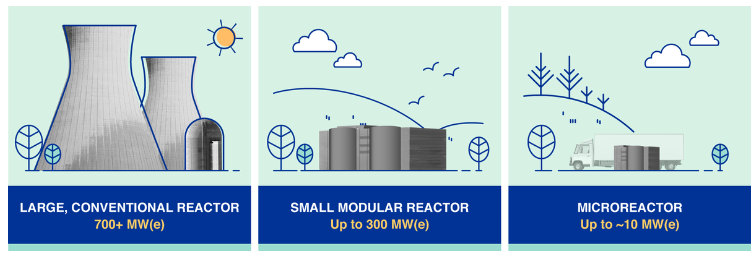
What are the Small Modular Reactors (SMRs)?
- They are advanced nuclear reactors that have a power capacity of up to 300 MW per unit, which is about one-third of the generating capacity of traditional nuclear power reactors.
SMRs are:
- Small: They are physically a fraction of the size of a conventional nuclear power reactor.
- Modular: Being mobile and agile technology, it makes it possible for systems and components to be factory-assembled and transported as a unit to a location for installation.
- Reactors: Which harnesses nuclear fission to generate heat to produce energy.
Global SMR Leadership and Strategic Importance
- India is positioning itself for a leadership role in SMRs to support its clean energy transition and leverage this as a technology-driven foreign policy tool.
- With Russia and China facing challenges expanding their SMR operations internationally, India sees an opportunity to establish itself as a credible alternative in the global SMR market.
Feasibility and Private Sector Involvement
- Discussions are underway within the government to explore the feasibility of SMR deployment under the Atomic Energy Act, 1962.
- There is also consideration of private sector and startup involvement, signaling a shift towards greater inclusivity in India’s civil nuclear sector.
SMRs and Grid Flexibility
- SMRs offer the potential to provide base load power, complementing renewable energy sources and addressing the challenge of intermittent renewable power output.
- With a smaller footprint than traditional reactors, SMRs are ideal for mid-sized grids and decentralized operations, offering carbon-neutral energy solutions.
India’s SMR Competence
- India’s historical expertise in small-sized reactors gives it an advantage in the SMR market.
- The country’s capability to produce and operate reactors cost-effectively positions it as a strong contender in the SMR space, especially as it seeks backing from countries like the U.S. for financing and technology dissemination.
Global Nuclear Industry Trends
- Amid declining global nuclear power output, India’s SMR initiative comes at a critical time.
- The global nuclear sector has seen a drop in output, influenced by factors such as safety concerns, policy shifts, and the rise of renewable energy.
- Countries like the U.S., France, and Germany are scaling down their nuclear operations, creating an opening for newer technologies like SMRs.
Benefits of SMR Technology
- SMRs are designed to be manufactured in controlled environments, optimizing construction lead time and reducing costs—two major concerns for traditional large reactors.
- This flexibility makes SMRs a commercially viable option in the current nuclear landscape.
| What are the challenges in its adoption of Small Modular Reactors? |
|
| PYQ: With growing energy needs should India keep on expanding its nuclear energy programme? Discuss the facts and fears associated with nuclear energy. (250 words/15m) (UPSC CSE (M) GS-3 2018) |
| Practice Question: Discuss the significance of Small Modular Reactors (SMRs) in India’s clean energy transition and its potential role in global nuclear leadership. What are the key challenges and opportunities associated with SMR deployment in the Indian context? (150 words/10 m) |
3. Study Reveals Genetic Diversity Loss in Indian Elephants Due to Historical Migration
(Source: Indian Express; Section: Cover Page; Page: 01)
| Topic: GS3 – Environment – Conservation |
| Context: |
|
Analysis of News:
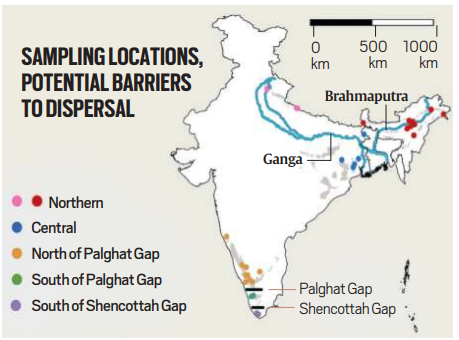
Key Findings
- Migration Path and Genetic Divergence: The study identified five genetically distinct populations of elephants in India, with the northern population diverging first, over 70,000 years ago. Elephants in central India diverged 50,000 years ago, while the southern populations split around 20,000 years ago.
- Genetic Diversity Loss: As elephants migrated south, they lost genetic diversity due to the “serial founder effect.” The southernmost population, found south of the Shencottah Gap, was identified as the most genetically vulnerable, consisting of fewer than 150 elephants.
Southern Elephant Populations
- The study challenges the previous understanding of elephant dispersal in the Western Ghats.
- It identified three distinct southern populations: one north of the Palghat Gap, one between Palghat and Shencottah, and one south of Shencottah.
Northern and Central Populations
- The northern elephant population extends along the Himalayan foothills, while central Indian elephants, found between southwestern West Bengal and eastern Maharashtra, represent another distinct genetic group.
- Rivers such as the Ganga and Brahmaputra act as natural barriers, further defining these populations.
Conservation Implications
- The reduced genetic diversity in southern elephant populations increases the risk of inbreeding and extinction.
- The research highlights the need for region-specific conservation strategies and underscores the importance of maintaining habitat connectivity, especially in the Western Ghats, where infrastructure development threatens gene flow.
Future Directions
- The research team plans to create a genetic toolkit for better monitoring of elephant populations and identification of individual elephants in the wild, aiming to enhance conservation efforts.
Conclusion
- This study provides valuable insights into elephant migration, genetic diversity, and the urgent need for tailored conservation strategies to protect vulnerable populations in India.
| Significance of Elephants in Ecosystem |
|
Elephants are very important grazers and browsers, eating vast amounts of vegetation every day, spreading seeds around as they go. They also help shape the often-thick vegetation of the Asian landscape. For example, in forests, elephants create clearings and gaps in the trees that let sunlight in to reach new seedlings, helping plants grow and the forest to regenerate naturally. Elephants will also dig for water when there is not any surface water – opening water access for other creatures as well as themselves. Elephants in India:
|
|
PYQ: With reference to Indian elephants, consider the following statements: (2020) The leader of an elephant group is a female. The maximum gestation period can be 22 months. An elephant can normally go on calving till the age of 40 years only. Among the States in India, the highest elephant population is in Kerala. Which of the statements given above is/are correct? (a) 1 and 2 only Ans: (a) |
| Practice Question: Discuss the implications of the recent study on the genetic diversity of Indian elephants for conservation strategies. How can tailored approaches be developed to address the challenges faced by the distinct elephant populations identified in the research? (150 words/10 m) |
4. Centre Lifts Ban on Non-Basmati White Rice Exports, Imposes Minimum Export Price of $490 per Tonne
(Source: Indian Express; Section: Explained; Page: 01)
| Topic: GS3 – Agriculture |
| Context: |
|
Analysis of News:
Reasons for Removing the Ban
- Higher Sowing: Increased monsoon rainfall has led to a rise in paddy cultivation, with the area under paddy increasing by 2.2% compared to last year.
- Record Production: Total rice production for 2023-24 is expected to reach 137.82 million tonnes, 1.5% higher than last year.
- Declining Wholesale Prices: Wholesale rice prices have decreased, but retail inflation remains elevated, peaking at 13.09% in July 2023.
- Surplus Stocks: The Food Corporation of India has surplus rice stocks, exceeding the buffer stock norms.
Impact of the Move
- Farmers and Traders: The lifting of the ban benefits farmers growing premium non-basmati varieties like Sona Masoori, as well as traders.
- Domestic Consumers: Retail prices may increase due to eased export restrictions.
- State Governments: States can now purchase rice for welfare schemes and distilleries for ethanol production.
India’s Status as a Rice Exporter
- India is the largest rice exporter in the world, accounting for 33% of global rice exports in 2023.
- India’s main competitors in the global market are Thailand and Vietnam.
Breakdown of India’s Rice Exports
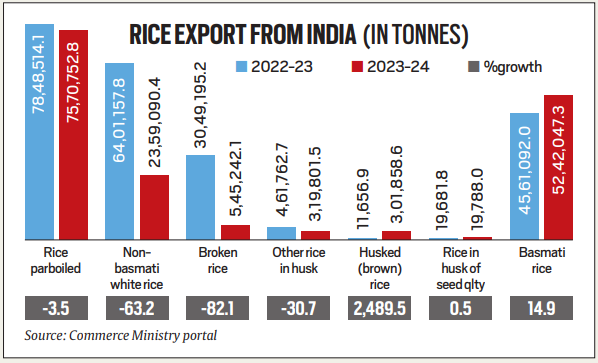
India’s rice exports are divided into basmati and non-basmati categories:
- Basmati Rice: Accounts for one-third of total rice exports (52.42 lakh tonnes in 2023-24).
- Non-Basmati Rice: Includes several subcategories such as husked rice, parboiled rice, and broken rice. Key importers include African and Southeast Asian countries.
| What are the Key Facts About Rice? |
|
|
PYQ: Among the following, which one is the largest exporter of rice in the world in the last five years? (2019) (a) China Ans: (b) |
| Practice Question: Discuss the economic and agricultural factors that led to the lifting of the export ban on non-basmati white rice in India. How will this decision impact domestic consumers, farmers, and India’s position in the global rice market? (150 words/10 m) |
Prelims Facts
1. Mithun Chakraborty to get Dadasaheb Phalke Award
(Source – The Hindu, International Edition – Page No. – 6)
| Context |
|
The Dadasaheb Phalke Award:
- The Dadasaheb Phalke Award is India’s highest recognition in the field of cinema.
- It was instituted in 1969 by the Government of India.
- Named after Dadasaheb Phalke, the father of Indian cinema, who directed Raja Harishchandra, the first full-length Indian feature film in 1913.
- The award is given for lifetime contribution to Indian cinema, honouring outstanding achievements and dedication.
- It includes a Swarna Kamal (Golden Lotus) medallion, a shawl, and a cash prize.
- The award is presented annually at the National Film Awards ceremony.
- The first recipient was actress Devika Rani, awarded in 1969.
- Prominent recipients include Raj Kapoor, Lata Mangeshkar, Satyajit Ray, and Amitabh Bachchan, acknowledging their impact on the Indian film industry.
2. Frigid planet offers glimpse of earth’s final fate
(Source – The Hindu, International Edition – Page No. – 7)
| Context |
|
Analysis of the news:
- A rocky planet has been found orbiting a white dwarf, providing a potential glimpse into Earth’s distant future.
| What Is White Dwarf? |
|
|
- The planet, with a mass about 1.9 times that of Earth, orbits a white dwarf 4,200 light-years away in the Milky Way galaxy’s central bulge.
- The white dwarf started as a star similar in mass to the Sun, now reduced to about half the Sun’s mass.
- The planet originally orbited within its host star’s habitable zone, at a distance similar to Earth’s from the Sun, but now orbits at 2.1 times that distance.
- The planet is currently extremely cold, as the white dwarf is much fainter than its original star.
- The Sun will eventually become a white dwarf after expanding into a red giant and shedding its outer layers.
- When the Sun becomes a white dwarf, Earth may be engulfed during its red giant phase or remain as a cold, lifeless planet orbiting the faint remnant of the Sun.
3. U.S. stays India’s top trading ally, export destination in 2024
(Source – The Hindu, International Edition – Page No. – 12)
| Context |
|
Analysis of the news:
- The U.S. remained India’s top trading partner in the January-July 2024 period, with bilateral goods trade surpassing $190 billion.
- Indian exports to the U.S. grew by 9.3%, reaching $48.2 billion during this period.
- Top exports from India included garments, textiles, pharmaceuticals, precious stones, smartphones, and mineral fuels.
- India’s imports from the U.S. declined by 5%, falling from $25.9 billion to $24.6 billion.
- India’s imports from the U.S. included mineral fuels, machinery, aircraft, chemicals, and edible fruits.
- India’s total exports to the U.S., including services, grew from $83.2 billion in 2018 to $120.1 billion in 2023.
- The U.S. withdrawal of the GSP scheme for Indian exporters had minimal economic impact.
4. U.K.’s last coal-fired power plant to shut, ending 142 years of coal power
(Source – The Hindu, International Edition – Page No. – 13)
| Context |
|
Britain’s last coal-fired power plant:
- Britain’s last coal-fired power plant, Ratcliffe-on-Soar station, will close on Monday, ending 142 years of coal-generated electricity.
- The plant, located in central England, will complete its final shift at midnight, with many of the 170 employees staying on for the decommissioning process.
- The U.K. government sees the closure as a key step toward generating all energy from renewable sources by 2030.
- Britain becomes the first G7 country to phase out coal.
- In 1990, coal provided 80% of Britain’s electricity; by 2023, it had fallen to 1%.
- More than half of Britain’s electricity now comes from renewables.
5. INDIA- KAZAKHSTAN JOINT MILITARY EXERCISE KAZIND -2024 COMMENCES IN AULI
(Source – https://pib.gov.in/PressReleseDetail.aspx?PRID=2060265®=3&lang=1 )
| Context |
|
Exercise KAZIND:
- KAZIND has been held annually since 2016; the previous edition was in Otar, Kazakhstan, in 2023.
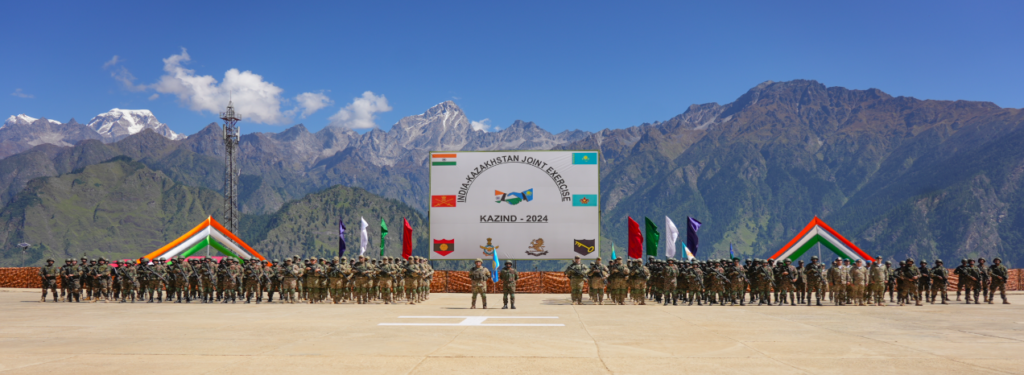
- The Indian contingent comprises 120 personnel from the KUMAON Regiment and Indian Air Force; Kazakhstan’s forces include Land Forces and Airborne Assault Troopers.
- The aim is to enhance joint capability for counterterrorism operations in semi-urban and mountainous terrain.
- Drills include joint response, intelligence setup, heliborne operations, cordon and search, drone use, and counter-drone tactics.
- The exercise focuses on enhancing interoperability, camaraderie, and defence cooperation between both nations.
6. India’s Impressive Leap in the Global Innovation Index 2024: A Testament to the Nation’s Growing Innovation Ecosystem
(Source – https://pib.gov.in/PressNoteDetails.aspx?NoteId=153223&ModuleId=3®=3&lang=1 )
| Context |
|
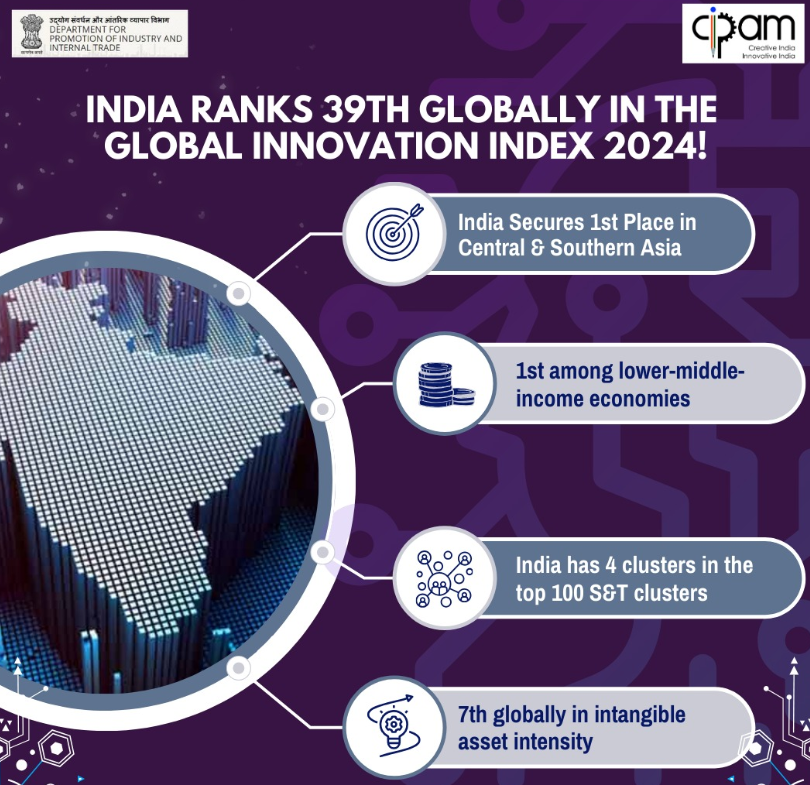
Analysis of the news:
- India achieved 39th position among 133 economies in the Global Innovation Index (GII) 2024, rising from 81st in 2015.
- This significant leap highlights India’s commitment to fostering a robust innovation ecosystem through policies, R&D investment, and startup-industry collaboration.
| Global Innovation Index (GII) |
|
Here’s a representation of India’s various rankings:
| Category | Ranking |
| Global Innovation Index 2024 | 39th out of 133 economies |
| Among Economies in Central and Southern Asia | 1st |
| Among Lower-Middle-Income Economies | 1st |
| Science & Technology Cluster (WIPO) | 4th globally |
| Cities in World’s Top 100 S&T Clusters | Mumbai, Delhi, Bengaluru, Chennai |
| Ranking In Intangible Asset Intensity | 7th globally |
| Innovation Outputs | 33rd globally |
Key Initiatives Driving Innovation in India:
- Initiatives like Start-Up India, Digital India, and Atal Innovation Mission have been pivotal in nurturing entrepreneurship and technological advancement.
- Start-Up India, launched in 2016, aims to transform India into a nation of job creators; over 1,49,414 startups are officially recognized by DPIIT.
- The Digital India programme focuses on digital empowerment, governance, and infrastructure.
- Atal Innovation Mission has established 10,000 Atal Tinkering Labs in schools and supported over 3,500 startups.
- India’s focus on public-private collaboration, intellectual property rights, and innovation infrastructure continues to boost its competitiveness globally.
| PYQ: Scientific research in Indian universities is declining, because a career in science is not as attractive as our business operations, engineering or administration, and the universities are becoming consumer oriented. Critically comment. (200 words/12.5m) (UPSC CSE (M) GS-3 2014) |
| Practice Question: Discuss the factors contributing to India’s rise in the Global Innovation Index. Analyse the role of government initiatives like Start-Up India and Digital India in fostering innovation and entrepreneurship. (250 Words /15 marks) |
7. Annual Survey of Industries (ASI) Results for 2022-23
(Source – https://pib.gov.in/PressReleseDetail.aspx?PRID=2060292®=3&lang=1 )
| Context |
|

What Is Annual Survey of Industries (ASI)?
- The Annual Survey of Industries (ASI) is a nationwide survey conducted by the Ministry of Statistics and Programme Implementation (MoSPI) in India.
- Its primary objective is to provide meaningful insights into the structure, growth, and composition of various manufacturing industries within the country.
- The ASI assesses several economic parameters, including output, value added, employment, and capital formation, which are essential for understanding the dynamics of the industrial sector.
- The results of the ASI contribute to the National Accounts Statistics at both national and state levels, helping policymakers and researchers analyse the industrial landscape and its impact on economic development.
Key highlights and findings from the Annual Survey of Industries 2022-23:
| Parameter | Details |
| Survey Reference Period | The ASI for the financial year 2022-23 covers the period from April 2022 to March 2023. |
| Gross Value Added (GVA) Growth | The GVA in the manufacturing sector grew by 7.3% in current prices in 2022-23 compared to 2021-22. |
| Industrial Output Growth | Industrial output increased by 21.5% in 2022-23 over the previous year. |
| Main Growth Drivers | Key industries driving growth included Manufacture of Basic Metals, Coke & Refined Petroleum Products, Food Products, Chemicals, and Motor Vehicles, contributing 58% of the total output. |
| Employment Growth | Estimated employment in the manufacturing sector in 2022-23 exceeded the pre-pandemic level (2018-19) by more than 22.14 lakh. |
| Top GVA States | Maharashtra ranked first in GVA for 2022-23, followed by Gujarat, Tamil Nadu, Karnataka, and Uttar Pradesh, contributing over 54% of total manufacturing GVA. |
| Top Employment States | Tamil Nadu, Maharashtra, Gujarat, Uttar Pradesh, and Karnataka were the top states for employment in manufacturing, accounting for about 55% of total manufacturing employment in 2022-23. |
| Practice Question: Discuss the recent trends in industrialization in India as highlighted by the Annual Survey of Industries (ASI) 2022-23. Analyse the factors contributing to the growth in Gross Value Added (GVA), industrial output, and employment in the manufacturing sector. (150 Words /10 marks) |




